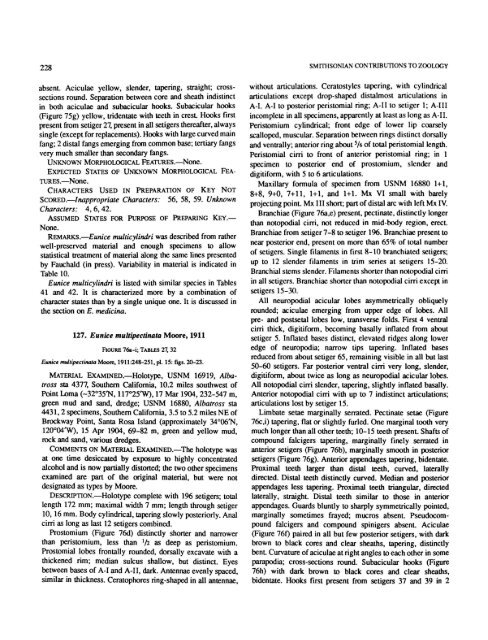A Review of the Genus Eunice - Smithsonian Institution Libraries
A Review of the Genus Eunice - Smithsonian Institution Libraries
A Review of the Genus Eunice - Smithsonian Institution Libraries
You also want an ePaper? Increase the reach of your titles
YUMPU automatically turns print PDFs into web optimized ePapers that Google loves.
228<br />
SMITHSONIAN CONTRIBUTIONS TO ZOOLOGY<br />
absent. Aciculae yellow, slender, tapering, straight; crosssections<br />
round. Separation between core and sheath indistinct<br />
in both aciculae and subacicular hooks. Subacicular hooks<br />
(Figure 75g) yellow, tridentate with teeth in crest. Hooks first<br />
present from setiger 27, present in all setigers <strong>the</strong>reafter, always<br />
single (except for replacements). Hooks with large curved main<br />
fang; 2 distal fangs emerging from common base; tertiary fangs<br />
very much smaller than secondary fangs.<br />
UNKNOWN MORPHOLOGICAL FEATURES.—None.<br />
EXPECTED STATES OF UNKNOWN MORPHOLOGICAL FEA-<br />
TURES.—None.<br />
CHARACTERS USED IN PREPARATION OF KEY NOT<br />
SCORED.—Inappropriate Characters: 56, 58, 59. Unknown<br />
Characters: 4, 6,42.<br />
ASSUMED STATES FOR PURPOSE OF PREPARING KEY.—<br />
None.<br />
REMARKS.—<strong>Eunice</strong> multicylindri was described from ra<strong>the</strong>r<br />
well-preserved material and enough specimens to allow<br />
statistical treatment <strong>of</strong> material along <strong>the</strong> same lines presented<br />
by Fauchald (in press). Variability in material is indicated in<br />
Table 10.<br />
<strong>Eunice</strong> multicylindri is listed with similar species in Tables<br />
41 and 42. It is characterized more by a combination <strong>of</strong><br />
character states than by a single unique one. It is discussed in<br />
<strong>the</strong> section on E. medicina.<br />
127. <strong>Eunice</strong> multipectinata Moore, 1911<br />
FIGURE 76a-i; TABLES 27, 32<br />
<strong>Eunice</strong> nudtipectinata Moore, 1911:248-251, pi. 15: figs. 20-23.<br />
MATERIAL EXAMINED.—Holotype, USNM 16919, Albatross<br />
sta 4377, Sou<strong>the</strong>rn California, 10.2 miles southwest <strong>of</strong><br />
Point Loma (~32°35'N, 117°25'W), 17 Mar 1904, 232-547 m,<br />
green mud and sand, dredge; USNM 16880, Albatross sta<br />
4431,2 specimens, Sou<strong>the</strong>rn California, 3.5 to 5.2 miles NE <strong>of</strong><br />
Brockway Point, Santa Rosa Island (approximately 34°06 / N,<br />
120°04'W), 15 Apr 1904, 69-82 m, green and yellow mud,<br />
rock and sand, various dredges.<br />
COMMENTS ON MATERIAL EXAMINED.—The holotype was<br />
at one time desiccated by exposure to highly concentrated<br />
alcohol and is now partially distorted; <strong>the</strong> two o<strong>the</strong>r specimens<br />
examined are part <strong>of</strong> <strong>the</strong> original material, but were not<br />
designated as types by Moore.<br />
DESCRIPTION.—Holotype complete with 196 setigers; total<br />
length 172 mm; maximal width 7 mm; length through setiger<br />
10,16 mm. Body cylindrical, tapering slowly posteriorly. Anal<br />
cirri as long as last 12 setigers combined.<br />
Prostomium (Figure 76d) distinctly shorter and narrower<br />
than peristomium, less than 1 /i as deep as peristomium.<br />
Prostomial lobes frontally rounded, dorsally excavate with a<br />
thickened rim; median sulcus shallow, but distinct. Eyes<br />
between bases <strong>of</strong> A-I and A-II, dark. Antennae evenly spaced,<br />
similar in thickness. Ceratophores ring-shaped in all antennae,<br />
without articulations. Ceratostyles tapering, with cylindrical<br />
articulations except drop-shaped distalmost articulations in<br />
A-I. A-I to posterior peristomial ring; A-II to setiger 1; A-III<br />
incomplete in all specimens, apparently at least as long as A-II.<br />
Peristomium cylindrical; front edge <strong>of</strong> lower lip coarsely<br />
scalloped, muscular. Separation between rings distinct dorsally<br />
and ventrally; anterior ring about 5 A <strong>of</strong> total peristomial length.<br />
Peristomial cirri to front <strong>of</strong> anterior peristomial ring; in 1<br />
specimen to posterior end <strong>of</strong> prostomium, slender and<br />
digitiform, with 5 to 6 articulations.<br />
Maxillary formula <strong>of</strong> specimen from USNM 16880 1+1,<br />
8+8, 9+0, 7+11, 1+1, and 1+1. Mx VI small with barely<br />
projecting point. Mx III short; part <strong>of</strong> distal arc with left Mx IV.<br />
Branchiae (Figure 76a,e) present, pectinate, distinctly longer<br />
than notopodial cirri, not reduced in mid-body region, erect.<br />
Branchiae from setiger 7-8 to sctiger 1%. Branchiae present to<br />
near posterior end, present on more than 65% <strong>of</strong> total number<br />
<strong>of</strong> setigers. Single filaments in first 8-10 branchiated setigcrs;<br />
up to 12 slender filaments in trim scries at sctigcrs 15-20.<br />
Branchial stems slender. Filaments shorter than notopodial cirri<br />
in all setigers. Branchiae shorter than notopodial cirri except in<br />
setigers 15-30.<br />
All neuropodial acicular lobes asymmetrically obliquely<br />
rounded; aciculae emerging from upper edge <strong>of</strong> lobes. All<br />
pre- and postsetal lobes low, transverse folds. First 4 ventral<br />
cirri thick, digitiform, becoming basally inflated from about<br />
setiger 5. Inflated bases distinct, elevated ridges along lower<br />
edge <strong>of</strong> neuropodia; narrow tips tapering. Inflated bases<br />
reduced from about setiger 65, remaining visible in all but last<br />
50-60 setigers. Far posterior ventral cirri very long, slender,<br />
digitiform, about twice as long as neuropodial acicular lobes.<br />
All notopodial cirri slender, tapering, slightly inflated basally.<br />
Anterior notopodial cirri with up to 7 indistinct articulations;<br />
articulations lost by setiger 15.<br />
Limbate setae marginally serrated. Pectinate setae (Figure<br />
76c,i) tapering, flat or slightly furled. One marginal tooth very<br />
much longer than all o<strong>the</strong>r teeth; 10-15 teeth present. Shafts <strong>of</strong><br />
compound falcigers tapering, marginally finely serrated in<br />
anterior setigers (Figure 76b), marginally smooth in posterior<br />
setigers (Figure 76g). Anterior appendages tapering, bidentate.<br />
Proximal teeth larger than distal teeth, curved, laterally<br />
directed. Distal teeth distinctly curved. Median and posterior<br />
appendages less tapering. Proximal teeth triangular, directed<br />
laterally, straight. Distal teeth similar to those in anterior<br />
appendages. Guards bluntly to sharply symmetrically pointed,<br />
marginally sometimes frayed; mucros absent. Pseudocompound<br />
falcigers and compound spinigers absent. Aciculae<br />
(Figure 76f) paired in all but few posterior setigers, with dark<br />
brown to black cores and clear sheaths, tapering, distinctly<br />
bent. Curvature <strong>of</strong> aciculae at right angles to each o<strong>the</strong>r in some<br />
parapodia; cross-sections round. Subacicular hooks (Figure<br />
76h) with dark brown to black cores and clear sheaths,<br />
bidentate. Hooks first present from setigers 37 and 39 in 2
















